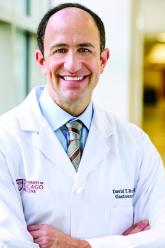News

Colorectal Cancer Is Spiking Among Some Young Americans
- Author:
- Damian McNamara, MA
Up to one third of early-onset colorectal cancer cases are linked to factors that cannot be changed.
News
Semaglutide Aids Weight Loss With or Without Bariatric Surgery
- Author:
- Damian McNamara, MA
In a comparison of people who had weight loss surgery with those who had not, total weight loss was almost identical: 5.8% in those who had...
News
Late-Night Eaters May Have Increased Risk for Colorectal Cancer
- Author:
- Damian McNamara, MA
Late eating could disrupt the peripheral circadian rhythm, part of which is found in the GI tract.
News
Healthy Sleep Linked to Lower Odds for Digestive Diseases
- Author:
- Damian McNamara, MA
Those with healthy sleep had more than a quarter lower risk of developing digestive disease, study finds.
News

Maintenance Treatment With Guselkumab for Ulcerative Colitis Meets All Endpoints: QUASAR
- Author:
- Damian McNamara, MA
Among the participants who achieved clinical remission, 69% of them also showed complete remission on endoscopy.
News
GI Complications With GLP-1s for Weight Loss: Reexamining the Risks
- Author:
- Damian McNamara, MA
The researchers found no significant association between GLP-1s and acute pancreatitis.
News
Genetic Test Can Predict Response to Semaglutide for Weight Loss
- Author:
- Damian McNamara, MA
Further prospective studies are needed to assess the validity of the test in a more diverse population and with different weight loss...
News

Endoscopic Procedure Targets ‘Hunger Hormone’ for Weight Loss
- Author:
- Damian McNamara, MA
Researchers targeted the gastric fundus because its mucosal lining contains 80%-90% of the cells that produce ghrelin.
News
Oral Microbiome Test Could Detect Gastric Cancer Earlier
- Author:
- Damian McNamara, MA
A noninvasive “swish and spit” test could be more accessible and allow for more widespread screening.
News
‘Thunderstorm Asthma’ Could Strike More Often With Climate Change
- Author:
- Damian McNamara, MA
Asthma exacerbated by airborne pollen and electricity during storms can make symptoms worse, and is likely more prevalent in the future.
News
Children and preteen use of melatonin as sleep aid increased
- Author:
- Damian McNamara, MA
Usage of melatonin more than doubled in children and teenagers from 2017 to 2020.
News
Jury still out on whether green tea lowers colon cancer risk
- Author:
- Damian McNamara, MA
Combining random trials so far shows no advantage from green tea. But there may still be a benefit.
News
Popular liver supplements lack data supporting efficacy, study shows
- Author:
- Damian McNamara, MA
“But our research revealed that strong scientific evidence supporting the efficacy of any of these supplements is currently lacking.”
News
Dupilumab promising for children aged 1-11 with EoE
- Author:
- Damian McNamara, MA
Dupilumab was recently approved for adult EOE. It’s been shown to have a good safety profile in adults.
News
SGLT2 inhibitors in type 2 diabetes linked to lower risk of developing GI cancers
- Author:
- Damian McNamara, MA
The study is notable for including people with ulcerative colitis and Crohn’s disease and for evaluating every GI cancer.
